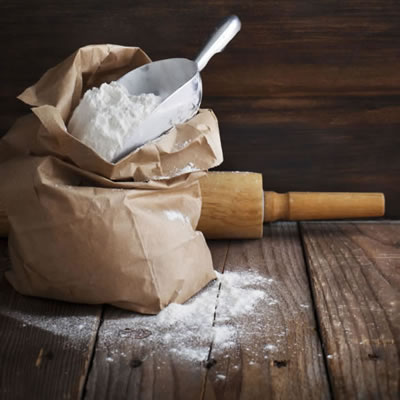
All-Purpose Flour
Also known as Plain Flour
What is All-purpose Flour?
All-purpose flour is a versatile and general use wheat flour. It is milled from hard red wheat or a blend of hard and soft wheats, typically 80:20 ratio. As the name suggests, all-purpose flour is suitable for all types of baked goods such as bread, biscuits, pizza, cookies, muffins, etc. It is also used in thickening gravies and sauces.
- Due to bran removal and loss of nutrients, all purpose flour is usually enriched with vitamins and minerals.
- It is available commercially as bleached or unbleached
Origin
Wheat flour is one of the most common food ingredients throughout the world. The availability of different wheat varieties has defined the types of baked goods adopted by populations. Millers can produce flours to meet commercial bakers’ needs for making cakes, breads, pastries, semolina, all-purpose and many others.
This type of flour was traditionally developed in the Southern region of the United States and then spread to the North. It is made either from:
- Hard wheat (bread flour)
- Blend of hard and soft flour (cake flour)
Commercial production
Several steps are involved in producing this flour:
- Wheat grains are milled to separate the endosperm from the bran and form all-purpose unbleached flour.
- At the end of the millstream, the flour can be bleached using bleaching-maturing agents to form bleached all-purpose flour.
- Fortification with vitamins (e.g. thiamine, riboflavin, folic acid) and minerals (iron, calcium) forms bleached fortified flour.
Composition and nutrition
Nutrients in AP flour (/100g):1
| Energy | 367 kcal |
| Protein | 10 g |
| Total lipid | 0 g |
| Carbohydrates | 76.67 g |
| Fiber | 3.3 g |
| Sugars | 0 g |
| Calcium | 33 mg |
| Iron | 4.33 mg |
| Potassium | 133 mg |
| Thiamin | 1 mg |
| Riboflavin | 0.33 mg |
Function
Functionality of all-purpose flour is determined by several factors, such as:2
- Ratio of hard wheat: soft wheat and the protein content of the flour
- Bleaching or maturing
Flour that is freshly milled or ‘green’ does not make doughs and bread with proper rheology and texture. So, there’s the need for aging or bleaching. This step is beneficial in terms of:
- Oxidizing the sulfhydryl groups of the protein, thus improving dough elasticity
- Whitening the flour
- Improving the baking characteristics.
Application
All-purpose flour is essential for the structure of traditional baked goods such as:
- Bread
- Cakes and muffins
- Cookies
- Noodles
- Pancake and pastries
- Pizza and pie crusts
It should be noted that cakes made of this type of flour are typically not as light or tender as cakes made out of cake flour. Similarly, bread made with all-purpose flour tends to be softer than that made of bread flour.
All-purpose flour can also be combined with other types of flour such as durum to produce semolina bread, whole wheat flour to produce whole wheat bread, or soybeans to produce spaghetti.
<h3 “=””>FDA regulation
Cereal flours are regulated by FDA under 21CFR137.105.3
References
- All-purpose flour. Access data. Fda. Gov. April 01. 2019. https://fdc.nal.usda.gov/fdc-app.html#/food-details/550231/nutrients. Last accessed by Jan 02. 2020.
- What are the functions of flour in baking? https://living.thebump.com/functions-flour-baking-8798.html. Last accessed by Jan 02. 2020.
- CFR – Code of Federal Regulations Title 21CFR137.105. Accessdata. Fda. gov. April 01. 2019. https://www.accessdata.fda.gov/scripts/cdrh/cfdocs/cfcfr/CFRSearch.cfm?fr=137.105. Last accessed by Jan 02. 2020.

